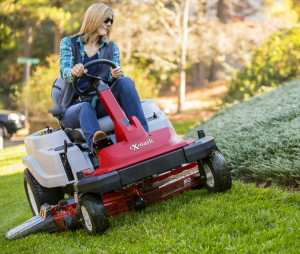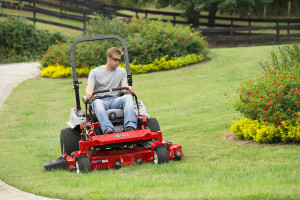
Whether mowing wide-open spaces or tackling a highly-landscaped lawn, zero-turn mowers get work done more efficiently.
Home and acreage owners with one or more acres of property are faced with more choices than ever when it comes to mower type, size, features and price. Among landscape maintenance professionals, it’s safe to say the zero-turn riding mower has become the tool of choice to consistently and quickly achieve a beautiful after-cut appearance. However, when it comes of homeowners, are zero-turn mowers still the preferred choice? Read on to find out.
Productivity: A faster mower = more free time
Landscape pros choose zero-turn mowers because they deliver the finished appearance their clients expect, and they do it more quickly than other mower types. And while it may be true that homeowners don’t have to make money with their mower, it’s a good idea to consider what their time is worth.

An increasing number of home and acreage owners have found the productivity benefits of a true commercial duty zero-turn rider like this Exmark Lazer Z.
Let’s take the case of an acreage owner with about 5 acres to mow, with moderate landscaping, a mixture of mature and small trees, and a kids’ play area in the back yard. We’ll compare lawn tractors and zero-turn mowers at three popular price points: $4,000-5,000; $7,000-8,000 and $13,000-14,000 in posts spread out over the next two weeks.
The comparisons will provide an estimate of the relative productivity that could be expected at each price point from a lawn tractor and zero-turn rider. That said, raw productivity numbers don’t factor in other aspects of mower performance such as maneuverability, durability, operator comfort or quality of cut. As a result, the ultimate productivity of a mower will depend on a combination of factors.
To determine the acres-per-hour productivity of each mower, we used the top speed of the mowers, along with the published width of the cutting deck. Since most mowers are not able to produce a good quality of cut at maximum speed, we assumed 80-percent efficiency from the mowers to account for this, as well as for time spent not actually cutting grass, such as turning around or overlap.
Look for our next installment of this series on Monday, January 11.
Dig Deeper at Exmark.com:
- Learn more about factors to consider when choosing a lawn tractor or zero-turn mower.
- Learn more about how to determine mower productivity.






